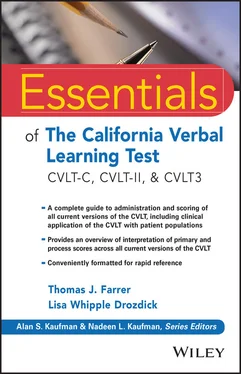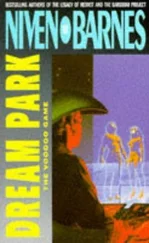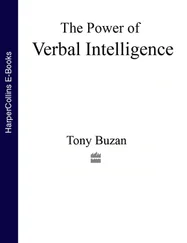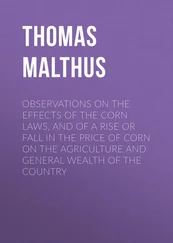b Scores not on the Short Form.
Difference scores compare performance on one task to performance on another task. On CVLT-II, difference (or savings) scores are derived using the sex- and age-corrected z -scores. Change and difference scores should not replace the primary scores but are used to guide interpretation of differences observed across conditions. Detailed information on the interpretation of scores is provided in Chapter 4.
OVERVIEW AND ORGANIZATION OF THE CVLT3
The CVLT3 is the most recent revision to the CVLT. The revision was guided by the need for updated normative data, feedback from users and reviewers of the CVLT-II (both personal and published), and research utilizing the CVLT-II. In terms of content, the administration instructions and word lists were not modified but remain the same as in the CVLT-II. However, a few items on the forced-choice recognition trial were modified to increase sensitivity as a measure of performance validity. The alternate and short forms were also retained with similar modifications made to the forced-choice recognition trial.
The CVLT3 addressed many needs identified in the research literature and customer feedback. Revisions made in the CVLT3 included:
updated norms for ages 16–90, using a nationally stratified sample matched to the U.S. population;
application of a scaled score metric (mean = 10, SD = 3) over the T score and z-score metric to allow easier comparison to other measures;
introduction of index scores (mean = 100, SD = 15) on the key memory and learning scores (Trials 1–5, total delayed recall, total recall);
updated intrusion measures to reflect different types of memory errors;
digital administration, recording, and scoring; and
provision of demographic adjustments to age-adjusted scores for education and sex presented as T scores in the scoring software.
Detailed information on the modifications and improvements to the content, psychometric properties, and clinical utility of the CVLT3 are described in the CVLT3 Manual . An overview of the changes is provided in Rapid Reference 1.4.
Rapid Reference 1.4
Changes from CVLT-II to CVLT3
New normative sample reflective of 2015 U.S. Census data
Increased age range to 90
Index scores on standard score metric (mean = 100, SD = 15)
Primary scores on scaled score metric (mean = 10, SD = 3)
Trials 1–5 Total score computed by summing scaled scores for Trials 1–5
Norms provided are age corrected only
Demographic adjustments to normative scores available for sex and education, presented as T scores
Forced-choice recognition items modified to include only concrete distractors (abstract distractors were removed)
New measures of across- and within-trial intrusions
New measures of intrusion error types
New yes/no recognition scores that describe the types of recognition errors
The CVLT3 introduced significant changes to the scoring of the CVLT-II. Although scores still measure the processes underlying attention, learning, and memory, the traditional T score and z -score metrics were changed to standard and scaled scores. This allows direct comparison to other measures commonly used in evaluations. Three index scores are derived by summing the scaled scores for the learning trials (Trials 1–5), for the delayed recall trials (free and cued recall), and for all recall trials (learning, interference, short delay, and long delay). For the primary process scores, age-corrected scaled scores were derived with a mean of 10 and a standard deviation of 3. In addition, cumulative percentages are provided for some scores that had highly skewed distributions. The normative scores derived in CVLT3 are listed in Rapid Reference 1.5by condition.
Contrast scores are utilized for difference scores in CVLT3. Contrast scaled scores provide information about performance on one task adjusted for performance on another relevant task. Similar to the manner in which demographic adjustments are derived for normative scores, one score is adjusted to account for performance on a related but separate score. For example, the Long-Delay Free-Recall Correct vs. Short-Delay Free-Recall Correct Contrast Scaled Score adjusts the long-delay score based on performance on short-delay recall. This accounts for differences in performance on delayed memory due to differences in immediate recall. The new score represents the examinee's performance on delayed memory in comparison to individuals of similar immediate memory ability. Because contrast scores utilize age-adjusted scaled scores, they are not further adjusted by age. Contrast scaled scores are provided at the scaled score level and are presented as scaled scores with a mean of 10 and a standard deviation of 3. Contrast scores are used to interpret scores in relation to similar ability peers; they do not replace subtest scaled scores and should not be substituted for primary scores in reports or to compute index scores. Detailed information on the interpretation of contrast scaled scores is provided in Chapter 4.
The CVLT3 introduces the use of demographic adjustments to norms. In addition to the age-adjusted normative scores, education, and sex adjustments are provided in the scoring software. The demographic adjustments are applied to the normative scores to produce T scores that account for education and sex differences.
Rapid Reference 1.5
Primary Scores Derived in CVLT3, by Condition
| Learning trials |
Recall scores |
Recognition scores |
| Trial 1 Correct a Trial 2 Correct a Trial 3 Correct a Trial 4 Correct a Trial 5 Correct a , b Trials 1–5 Correct (standard score) a List B Correct a , b List B Correct vs. Trial 1 Correct (contrast score) |
Short-Delay Free-Recall Correct a Short-Delay Cued-Recall Correct a , b Short-Delay Free-Recall Correct vs. Trial 5 Correct (contrast score) Long-Delay Free-Recall Correct a Long-Delay Cued-Recall Correct a Delayed Recall Correct (standard score) Total Recall Correct (standard score) Total Recall Responses (standard score) |
Long-Delay Yes/No Recognition Total Hits a Long-Delay Yes/No Recognition Total False Positives a Recognition Discriminability ( d' ) Recognition Discriminability Nonparametric Long-Delay Free-Recall vs. Recognition Discriminability ( d' ) (contrast score) Long-Delay Forced-Choice Recognition Hits a Long-Delay Free-Recall Discriminability vs. Recognition Discriminability ( d' ) (contrast score) |
|
Long-Delay Free-Recall Correct vs. Trial 5 Correct (contrast score)Long-Delay Free-Recall Correct vs. Short-Delay Free-Recall Correct (contrast score)Total Intrusions a |
|
a Scores that are easily hand scored.
b Scores not on the Short Form.
Learning and memory have long been of interest to psychologists, with William James first proposing the concepts of short-term and long-term memory in 1890. Short-term memory was described as finite with low durability unless it was encoded into long-term memory that was more lasting and of infinite capacity. Ebbinghaus' (1885) famous experiments on memory described the processes of learning and forgetting and introduced the concepts of the learning curve (rate at which information is acquired over repeated trials), serial position effects (how position within a series of words impacts recall), and the forgetting curve (rate at which one forgets information with most decay occurring within the first 20 min after learning). These early descriptions and investigations into memory laid the groundwork for modern memory assessment.
Despite Ebbinghaus' experiments on the processes of learning and memory, the assessment of these concepts has historically focused on the amount of information an individual could encode, consolidate, and recall. Encoding is the process of taking external information and transforming it into mental representations or memories. Consolidation is the process through which information in immediate memory is moved into long-term memory, and retrieval is the process of recalling information from storage. Focus on the amount of recalled information allows a global picture of memory ability, including the determination of the presence of memory disorders.
Читать дальше












